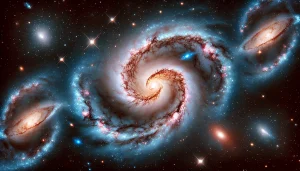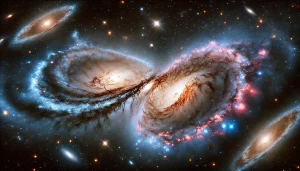The universe is a grand stage where stars, planets, and galaxies perform an eternal ballet. This cosmic dance is both enchanting and awe-inspiring, showcasing movements that span millions of light-years and billions of years in the making. Among the most captivating of these celestial performances are the collisions between galaxies—a mesmerizing interplay of gravity, light, and dark matter. Let’s dive into this spectacular phenomenon and uncover the intricate dance and dramatic flair of colliding galaxies.

Cosmic Choreography: Galaxies in Motion
Galaxies, those magnificent islands of stars, are in constant motion, guided by the invisible hand of gravity. This motion is not random but follows a well-choreographed cosmic dance. Each galaxy, whether spiral, elliptical, or irregular, moves in a symphony orchestrated by the gravitational forces exerted by its neighbors and the mysterious dark matter that permeates the universe. These movements occur over colossal timescales, making them an exquisite slow dance that we can only appreciate through the lens of powerful telescopes and simulations.
Spiral galaxies, like our own Milky Way, twirl gracefully with their spiral arms extending outward, while elliptical galaxies glide along more sedate, elliptical paths. Irregular galaxies, on the other hand, seem to freestyle, their shapes and movements less predictable and more chaotic. Yet, all these galaxies are bound to a larger cosmic rhythm, moving within galaxy clusters and superclusters, which in turn are also part of an even grander movement within the cosmic web.
The beauty of this cosmic choreography is that it is both predictable and mysterious. Scientists can model and predict the paths of galaxies based on current observations, yet the vastness of time and space means there are always surprises in store. It’s a celestial waltz that keeps astronomers and stargazers fascinated, continually looking up at the night sky and wondering what new dance will unfold next.

Stellar Spectacles: The Drama of Galactic Collisions
When galaxies collide, the universe puts on its most dramatic show. These collisions are not the catastrophic crashes one might imagine, but rather, a slow, intricate dance of two galaxies merging over millions or even billions of years. As they approach, the gravitational forces between them pull and distort their shapes, creating stunning tidal tails, bridges, and other ephemeral structures that glimmer against the dark backdrop of space.
During these cosmic encounters, stars within the galaxies rarely collide due to the vast distances between them. Instead, the interstellar gas and dust clouds within the galaxies interact more directly, triggering bursts of star formation. These starburst regions shine brilliantly, often birthing new stars at rates hundreds of times faster than usual. The resulting light shows are nothing short of spectacular, as young, hot stars illuminate the collision zones with their radiant energy.
Perhaps one of the most dramatic outcomes of galactic collisions is the eventual merging of the two into a single, larger galaxy. This process can reshape the structure of the resulting galaxy, often transforming spirals into elliptical galaxies. The central supermassive black holes of the colliding galaxies may also merge, unleashing enormous amounts of energy and potentially affecting the dynamics of the entire galaxy. It’s a cosmic drama with acts spanning eons, leaving behind galaxies that bear the scars and beauty of their turbulent pasts.
The dance of colliding galaxies is a testament to the dynamic and ever-changing nature of the universe. It’s a performance that combines elegance with drama, slow-motion ballet with spectacular light displays. As we continue to observe and understand these majestic events, we gain not only scientific insights but also a deeper appreciation for the beauty and complexity of the cosmos. So next time you gaze up at the stars, remember that somewhere out there, galaxies are engaging in their timeless dance, weaving the story of the universe one step at a time.








